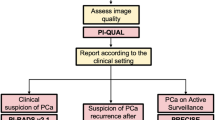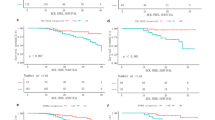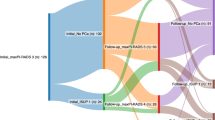Abstract
Objective
To evaluate the performance of a multiparametric MRI radiomics-based nomogram for the individualised prediction of synchronous distant metastasis (SDM) in patients with clear cell renal cell carcinoma (ccRCC).
Methods
Two-hundred and one patients (training cohort: n = 126; internal validation cohort: n = 39; external validation cohort: n = 36) with ccRCC were retrospectively enrolled between January 2013 and June 2019. In the training cohort, the optimal MRI radiomics features were selected and combined to calculate the radiomics score (Rad-score). Incorporating Rad-score and SDM-related clinicoradiologic characteristics, the radiomics-based nomogram was established by multivariable logistic regression analysis, then the performance of the nomogram (discrimination and clinical usefulness) was evaluated and validated subsequently. Moreover, the prediction efficacy for SDM in ccRCC subgroups of different sizes was also assessed.
Results
Incorporating Rad-score derived from 9 optimal MR radiomics features (age, pseudocapsule and regional lymph node), the radiomics-based nomogram was capable of predicting SDM in the training cohort (area under the ROC curve (AUC) = 0.914) and validated in both the internal and external cohorts (AUC = 0.854 and 0.816, respectively) and also showed a convincing predictive power in ccRCC subgroups of different sizes (≤ 4 cm, AUC = 0.875; 4–7 cm, AUC = 0.891; 7–10 cm, 0.908; > 10 cm, AUC = 0.881). Decision curve analysis indicated that the radiomics-based nomogram is of clinical usefulness.
Conclusions
The multiparametric MRI radiomics-based nomogram could achieve precise individualised prediction of SDM in patients with ccRCC, potentially improving the management of ccRCC.
Key Points
• Radiomics features derived from multiparametric magnetic resonance images showed relevant association with synchronous distant metastasis in clear cell renal cell carcinoma.
• MRI radiomics-based nomogram may serve as a potential tool for the risk prediction of synchronous distant metastasis in clear cell renal cell carcinoma.






Similar content being viewed by others
Abbreviations
- AUC:
-
Area under the ROC curve
- ccRCC:
-
Clear cell renal cell carcinoma
- DCA:
-
Decision curve analysis
- EP:
-
Excretory phase
- MRI:
-
Magnetic resonance imaging
- Rad-score:
-
Radiomics score
- RLN:
-
Regional lymph node
- ROC:
-
Receiver operating characteristic
- SDM:
-
Synchronous distant metastasis
References
Bray F, Ferlay J, Soerjomataram I, Siegel RL, Torre LA, Jemal A (2018) Global cancer statistics 2018: GLOBOCAN estimates of incidence and mortality worldwide for 36 cancers in 185 countries. CA Cancer J Clin 68:394–424
Patard JJ, Leray E, Rioux-Leclercq N et al (2005) Prognostic value of histologic subtypes in renal cell carcinoma: a multicenter experience. J Clin Oncol 23:2763–2771
Kammerer-Jacquet SF, Brunot A, Pladys A et al (2017) Synchronous metastatic clear-cell renal cell carcinoma: a distinct morphologic, immunohistochemical, and molecular phenotype. Clin Genitourin Cancer 15:e1–e7
Dabestani S, Thorstenson A, Lindblad P, Harmenberg U, Ljungberg B, Lundstam S (2016) Renal cell carcinoma recurrences and metastases in primary non-metastatic patients: a population-based study. World J Urol 34:1081–1086
Donskov F, Xie W, Overby A et al (2020) Synchronous versus metachronous metastatic disease: impact of time to metastasis on patient outcome-results from the International Metastatic Renal Cell Carcinoma Database Consortium. Eur Urol Oncol. https://doi.org/10.1016/j.euo.2020.01.001
Gill DM, Hahn AW, Hale P, Maughan BL (2018) Overview of current and future first-line systemic therapy for metastatic clear cell renal cell carcinoma. Curr Treat Options Oncol 19:6
Kato S, Demura S, Murakami H, Tsuchiya H (2019) Surgical metastasectomy for renal cell carcinoma: which patients are the real candidates for surgery? Ann Transl Med 7:S273
Nizam A, Schindelheim JA, Ornstein MC (2020) The role of active surveillance and cytoreductive nephrectomy in metastatic renal cell carcinoma. Cancer Treat Res Commun 23:100169
Ljungberg B, Bensalah K, Canfield S et al (2015) EAU guidelines on renal cell carcinoma: 2014 update. Eur Urol 67:913–924
Kunkle DA, Crispen PL, Li T, Uzzo RG (2007) Tumor size predicts synchronous metastatic renal cell carcinoma: implications for surveillance of small renal masses. J Urol 177:1692–1697
Thompson RH, Hill JR, Babayev Y et al (2009) Metastatic renal cell carcinoma risk according to tumor size. J Urol 182:41–45
Guðmundsson E, Hellborg H, Lundstam S, Erikson S, Ljungberg B (2011) Metastatic potential in renal cell carcinomas ≤7 cm: Swedish Kidney Cancer Quality Register data. Eur Urol 60:975–982
Diaz de Leon A, Pirasteh A, Costa DN et al (2019) Current challenges in diagnosis and assessment of the response of locally advanced and metastatic renal cell carcinoma. Radiographics 39:998–1016
Rasmussen F (2013) Metastatic renal cell cancer. Cancer Imaging 13:374–380
Hou TC, Wu CC, Yang CR, Wang J (2010) Synchronous renal cell carcinoma and clear cell hepatocellular carcinoma mimicking metastatic disease. Pathol Res Pract 206:342–345
Lyu HL, Cao JX, Wang HY et al (2018) Differentiation between pancreatic metastases from clear cell renal cell carcinoma and pancreatic neuroendocrine tumor using double-echo chemical shift imaging. Abdom Radiol (NY) 43:2712–2720
Yu J, Xu Q, Huang DY et al (2017) Prognostic aspects of dynamic contrast-enhanced magnetic resonance imaging in synchronous distant metastatic rectal cancer. Eur Radiol 27:1840–1847
Mendoza DP, Dagogo-Jack I, Chen T et al (2019) Imaging characteristics of BRAF-mutant non-small cell lung cancer by functional class. Lung Cancer 129:80–84
Aerts HJ, Velazquez ER, Leijenaar RT et al (2014) Decoding tumour phenotype by noninvasive imaging using a quantitative radiomics approach. Nat Commun 5:4006. https://doi.org/10.1038/ncomms5006
Shinagare AB, Krajewski KM, Braschi-Amirfarzan M, Ramaiya NH (2017) Advanced renal cell carcinoma: role of the radiologist in the era of precision medicine. Radiology 284:333–351
Mazurowski MA (2015) Radiogenomics: what it is and why it is important. J Am Coll Radiol 12:862–866
Wang W, Cao KM, Jin SM, Zhu XL, Ding JH, Peng WJ (2020) Differentiation of renal cell carcinoma subtypes through MRI-based radiomics analysis. Eur Radiol. https://doi.org/10.1007/s00330-020-06896-5
Deng Y, Soule E, Samuel A et al (2019) CT texture analysis in the differentiation of major renal cell carcinoma subtypes and correlation with Fuhrman grade. Eur Radiol 29:6922–6929
Li ZC, Zhai GT, Zhang JH et al (2019) Differentiation of clear cell and non-clear cell renal cell carcinomas by all-relevant radiomics features from multiphase CT: a VHL mutation perspective. Eur Radiol 29:3996–4007
Bektas CT, Kocak B, Yardimci AH et al (2019) Clear cell renal cell carcinoma: machine learning-based quantitative computed tomography texture analysis for prediction of Fuhrman nuclear grade. Eur Radiol 29:1153–1163
Zhang Y, Zhu Y, Shi X et al (2019) Soft tissue sarcomas: preoperative predictive histopathological grading based on radiomics of MRI. Acad Radiol 26:1262–1268
Shu J, Tang Y, Cui J et al (2018) Clear cell renal cell carcinoma: CT-based radiomics features for the prediction of Fuhrman grade. Eur J Radiol 109:8–12
Kocak B, Ates E, Durmaz ES, Ulusan MB, Kilickesmez O (2019) Influence of segmentation margin on machine learning-based high-dimensional quantitative CT texture analysis: a reproducibility study on renal clear cell carcinomas. Eur Radiol 29:4765–4775
Zwanenburg A, Leger S, Vallières M, Löck S (2016) Image biomarker standardisation initiative - feature definitions. arXiv:1612.07003
Park JE, Park SY, Kim HJ, Kim HS (2019) Reproducibility and generalizability in radiomics modeling: possible strategies in radiologic and statistical perspectives. Korean J Radiol 20:1124–1137
Rao SJ (2003) Regression modeling strategies: with applications to linear models, logistic regression, and survival analysis. J Am Stat Assoc 98:257–258
Vickers AJ, Elkin EB (2006) Decision curve analysis: a novel method for evaluating prediction models. Med Decis Making 26:565–574
Balachandran VP, Gonen M, Smith JJ, DeMatteo RP (2015) Nomograms in oncology: more than meets the eye. Lancet Oncol 16:e173–e180
Klatte T, Patard JJ, de Martino M et al (2008) Tumor size does not predict risk of metastatic disease or prognosis of small renal cell carcinomas. J Urol 179:1719–1726
Zastrow S, Phuong A, von Bar I, Novotny V, Hakenberg OW, Wirth MP (2014) Primary tumor size in renal cell cancer in relation to the occurrence of synchronous metastatic disease. Urol Int 92:462–467
Wei X, Wang J, Liu L et al (2018) Evaluation of tumor pseudocapsule status and its prognostic significance in renal cell carcinoma. J Urol 199:915–920
Karlo CA, Di Paolo PL, Chaim J et al (2014) Radiogenomics of clear cell renal cell carcinoma: associations between CT imaging features and mutations. Radiology 270:464–471
Zisman A, Wieder JA, Pantuck AJ et al (2003) Renal cell carcinoma with tumor thrombus extension: biology, role of nephrectomy and response to immunotherapy. J Urol 169:909–916
Gershman B, Takahashi N, Moreira DM et al (2016) Radiographic size of retroperitoneal lymph nodes predicts pathological nodal involvement for patients with renal cell carcinoma: development of a risk prediction model. BJU Int 118:742–749
Huhdanpaa H, Hwang D, Cen S et al (2015) CT prediction of the Fuhrman grade of clear cell renal cell carcinoma (RCC): towards the development of computer-assisted diagnostic method. Abdom Imaging 40:3168–3174
Kierans AS, Rusinek H, Lee A et al (2014) Textural differences in apparent diffusion coefficient between low- and high-stage clear cell renal cell carcinoma. AJR Am J Roentgenol 203:W637–W644
Ng F, Ganeshan B, Kozarski R, Miles KA, Goh V (2013) Assessment of primary colorectal cancer heterogeneity by using whole-tumor texture analysis: contrast-enhanced CT texture as a biomarker of 5-year survival. Radiology 266:177–184
Yang Y, Wang WW, Ren Y et al (2019) Computerized texture analysis predicts histological invasiveness within lung adenocarcinoma manifesting as pure ground-glass nodules. Acta Radiol 60:1258–1264
Cui EM, Li ZY, Ma CY et al (2020) Predicting the ISUP grade of clear cell renal cell carcinoma with multiparametric MR and multiphase CT radiomics. Eur Radiol 30:2912–2921
Acknowledgements
We thank Dr. Lin Li (PhD) (Professor, Medical Statistics, Institute for Hospital Management Research, Chinese PLA General Hospital) for his guidance on the statistical analysis in this study.
Funding
We acknowledge the financial support from the National Natural Science Foundation of China (Grant No. 81971580) and from the Medical Big Data Research and Development Project supported by Chinese PLA General Hospital (Grant No. 2018MBD-023).
Author information
Authors and Affiliations
Corresponding author
Ethics declarations
Guarantor
The scientific guarantor of this publication is Dr. Haiyi Wang.
Conflict of interest
The authors of this manuscript declare no conflict of interests.
Statistics and biometry
No complex statistical methods were necessary for this paper.
Informed consent
Written informed consent was waived by the institutional review board.
Ethical approval
Institutional review board approval was obtained.
Methodology
• Retrospective
• Diagnostic or prognostic study
• Multicentre study
Additional information
Publisher’s note
Springer Nature remains neutral with regard to jurisdictional claims in published maps and institutional affiliations.
Electronic supplementary material
ESM 1
(DOCX 54 kb)
Rights and permissions
About this article
Cite this article
Bai, X., Huang, Q., Zuo, P. et al. MRI radiomics-based nomogram for individualised prediction of synchronous distant metastasis in patients with clear cell renal cell carcinoma. Eur Radiol 31, 1029–1042 (2021). https://doi.org/10.1007/s00330-020-07184-y
Received:
Revised:
Accepted:
Published:
Issue Date:
DOI: https://doi.org/10.1007/s00330-020-07184-y




